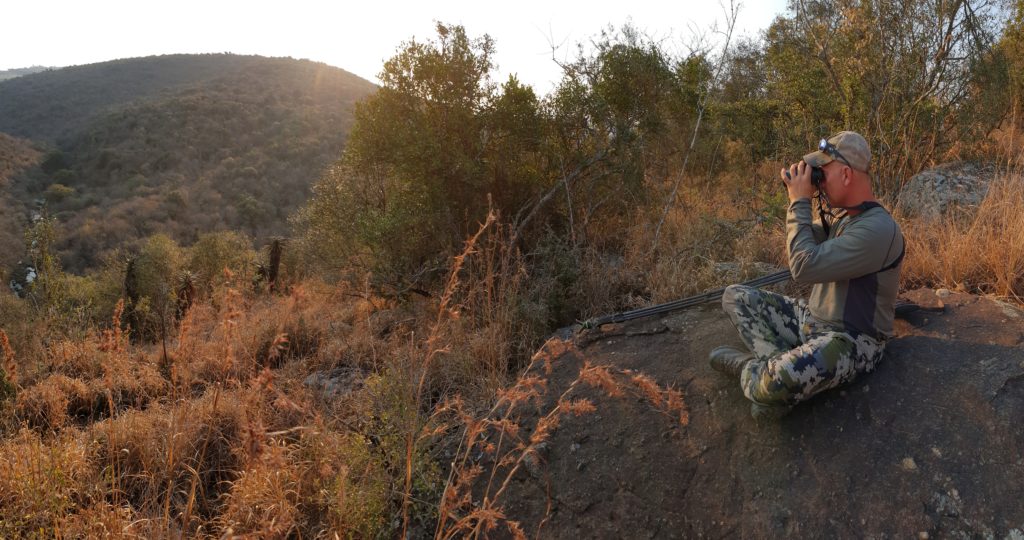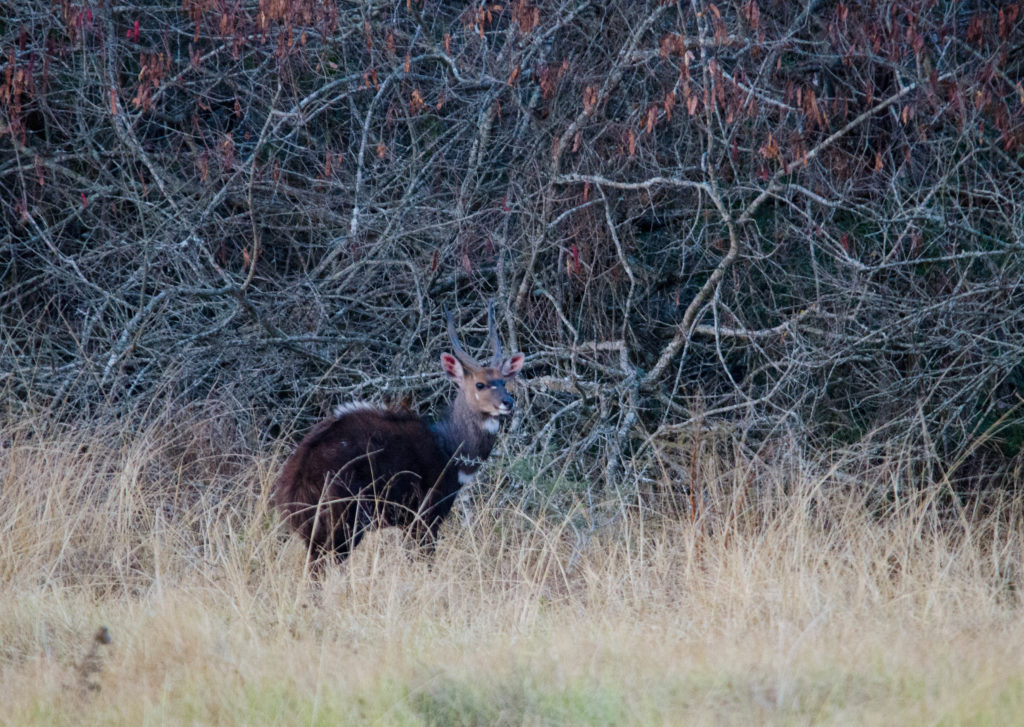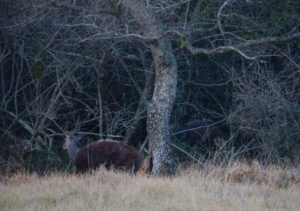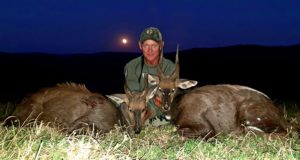There are some great destinations and species to pursue and it feels like every year that bucket list just seems to grow and grow. But I think, no matter where the path of adventure will lead me, A spiral horn hunt will always give me that warm fuzzy feeling inside. In the process we all undergo working towards becoming good hunters, these species seem to test the hunter to no end. In the thick vegetation of the Nhlamvini valleys, they are masters of their environment and just as you think you could have him figured out, the tables are turned and you back at square one.

Glassing the Valleys of the Nhlamvini
2018 was another year of some extremely memorable hunts. Some, successful in putting a beautiful trophy in the salt and meat in the cold-room and others leaving with an erasable blueprint of that last sight of that big old bull, disappearing into the tangle of thorns along the river. Regardless of the result, it is the adventure we chase, being out in the field, on their terms and becoming participants in the environment around us. Yet that success has never tasted so sweet when all the odds finally seem to play in your favour.
Our client, now friend, Matt, enjoyed a safari of a lifetime on his first trip into the valleys of the Nhlamvini in July this year. We shared some incredible experiences together and Matt’s love and respect for wildlife and the environment was prevalent in the way he conducted himself when hunting. We enjoyed some fantastic hunting, harvesting some incredible trophies during his stay. The primary species Matt was pursuing was the spiral horns, and in particular to get a beautiful, old, thick curled Kudu bull, a dream trophy that some, like Matt, has pursued and dreamt of all their life. We covered a lot of ground, working valleys thoroughly, by glassing known areas, before moving off onto the next.
The big, old, wise bulls in the valley, have got that way by being smart, very smart. Too much vehicle activity, or people activity and these bulls… evaporate! Discretion and stealth is thus paramount when in the field after one of these old bulls. Being on the reserve on a permanent basis and hunting and getting to know these valleys a bit more every day, we get an idea of the movements and areas of some of these big, old bulls, that are close to the end of their life, no longer adding to the genetic pool and a great trophy harvest. Their movements definitely do change with seasons, as availability of food changes too. Predicting the whereabouts of a Bushbuck, Nyala and Kudu is one thing, but in most cases it plays out a lot different in reality. There has been countless times when you briefly see a massive specimen crossing ahead, disappearing like a flea on a buffalo, into the thick undergrowth, and despite numerous efforts, over following months, and years, never to be seen again.
The most successful method for us in the valleys of the Nhlamvini is to use one of the multiple look out areas we have scattered around. These points are great vantage spots and have open gaps in the Brush on the opposite valley, within shooting range. Neither the male nor the female defend any part of their home range, so many ranges overlap, and by spending time at these points, you pick up on the local rams of the area, although mature bushbuck rams make a point of staying out of one another’s way. They tend to walk with very deliberate high-legged steps, frequently placing the hind foot in the exact spot where the forefoot had been, in an effort to negotiate the tangled undergrowth. Afternoons, at the very, very last light, the Bushbuck movements usually spike. At that point when you are just about to call it a day, and your numb back- side tells the story of the last few hours; he would appear, out of nowhere.

Typical Lookout point. This particular spot is known as Lynx Lookout & has produced some fantastic Nyala, Kudu and Bushbuck
On Matt’s fourth afternoon it was no different. We set out for the far North Western side of the reserve on Watervale. Old agricultural lands ,now turned grassland, lay next to the Nhlamvini river, bordered by some of that iconic riverine and valley thickets. Bushbuck are mainly browsers but are also known to eat grass when out from their usual habitat of the understory. They are selective feeders, but during hardship are able to adapt their feeding habits for the sake of survival. With the winter conditions taking its toll on the vegetation, this is exactly what was happening. We set ourselves out on the fringe of the highest point, with a great view of the open grass stretches ahead and the wait commenced.

Bushbuck ram that has moved out of cover into open adjacent grass patch.

Another Bushbuck Ram enters the picture in the thicket. The rams display but avoid confrontation
Prior to this afternoon we have glassed a number of Bushbuck, one in particular that was a definite shooter, but all our stalks and attempts came short in some manner against these unobtrusive, dexterous antelope. We felt good about this afternoon but with every hour that passes, you can’t help but feel the itch, the temptation, of maybe moving onto the next move, although your gut is telling you to stay put. Stay patient.
We were down to the last 15mins of shootable light and the sun had already shed its last rays into the valley. As the shade of the mountains engulfs the last spots of light, a complete calmness sets in over the Bush. An absolute magical time to be out there, a sensory overload at the worst of times! With time to almost call it, we got up to slowly move along the tree line, and suddenly, out of nowhere, a ram moves into the open about 600 yards ahead. Time was not in our favour and unless we can get really close, really quickly, we will not have enough light to guarantee a clean, one shot kill. A wounded Bushbuck in low light? No thanks! We set out scampering as fast as we can, yet still keeping any noise to an absolute minimum. “Head down we move, Head up we pause.”
After 4 days of hunting you know that this could possibly be the ‘shooter’ and the adrenaline slowly starts to surge. We quickly move up onto the side of a isolated thicket along the grass slope. We catch our breath briefly for a few seconds before slowly coming over the blind rise ahead. The bushbuck is 100 yards ahead, feeding, broadside. The sunset behind him is in full display of oranges and yellows, a vivid scene that I will never forget. It was a superb ram. No record breaker, but a thick set, old ram, which is exactly what we are looking for. Matt was on the sticks and all ready to go at my command and the shot echoed down the valley. The Ram fell right in his step, the .270 win, 130gr bullet doing exactly what we have come to expect of it. We looked at each other in awe of the moment but as we turned back, we see a broad- side, standing, Bushbuck ram! I slammed my binos back on my face, and a mere 30 yards from where the first bushbuck lay, another had stood up after the shot of the first one. With the last minutes of light available to us, we could make out that one horn was broken and what seemed to be the remains of a snare around his neck.
We knew we had to take this ram out and once again Matt was ready at my command, laying him down on the spot with one, clean shot. A silence hang over us. Even Boya, our tracker, who usually explodes with excitement on a hard earned, clean, one shot kill, was as serene and quite as the mountains around us. The emotions of the last 4 days of pursuing and searching for the right bushbuck had all come to a head right here, and in what a spectacular fashion. The second ram did have a snare around its neck that he had managed to brake off, but not without cutting very deeply into his neck. We removed the remainder of the cable snare, a harsh reminder of the reality our Wildlife faces. The other, also, a beautiful old ram, with battle scars and patches to substantiate his years of battles. As we set up for pictures, a full moon rose behind Matt and his Bushbuck , creating a scene that will be embedded in us forever.

We hunted for a further 4 days, managing to put some more fantastic trophies in the salt and ended it off with a spine-tingling Kudu hunt for the book, but this is definitely a story for another day!
